Business Environment Report: Contrasting Tesco and Primark Businesses
VerifiedAdded on 2020/09/03
|12
|3088
|71
Report
AI Summary
This report provides an in-depth analysis of the business environments of Tesco and Primark, focusing on various aspects such as their business types, purposes, and ownership structures. It explores the influence of different stakeholders on the businesses, including customers, suppliers, and employees, and examines how these stakeholders impact the companies' objectives. The report also delves into the organizational structures of both Tesco and Primark, comparing how their respective styles help them achieve their goals. Furthermore, it investigates the impact of economic environments, specifically growth and recession, on the business activities of the selected organizations. The report also discusses the influence of political, legal, and social factors on the business activities and their stakeholders. The report concludes with a comparative analysis of Tesco and Primark, highlighting key differences and similarities in their approaches to business and the challenges they face in the competitive retail landscape. The report references relevant academic sources and industry publications to support its findings.
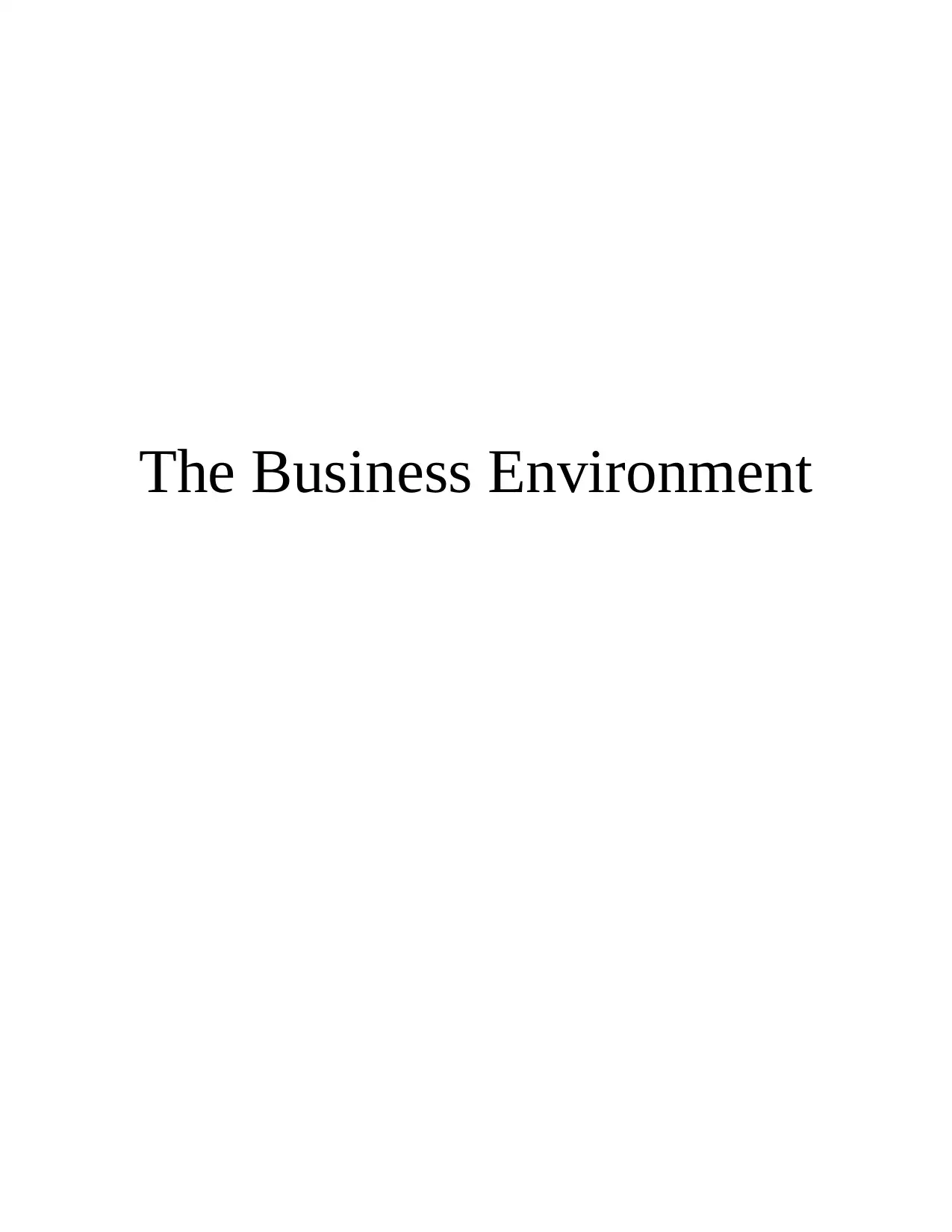
The Business Environment
Paraphrase This Document
Need a fresh take? Get an instant paraphrase of this document with our AI Paraphraser
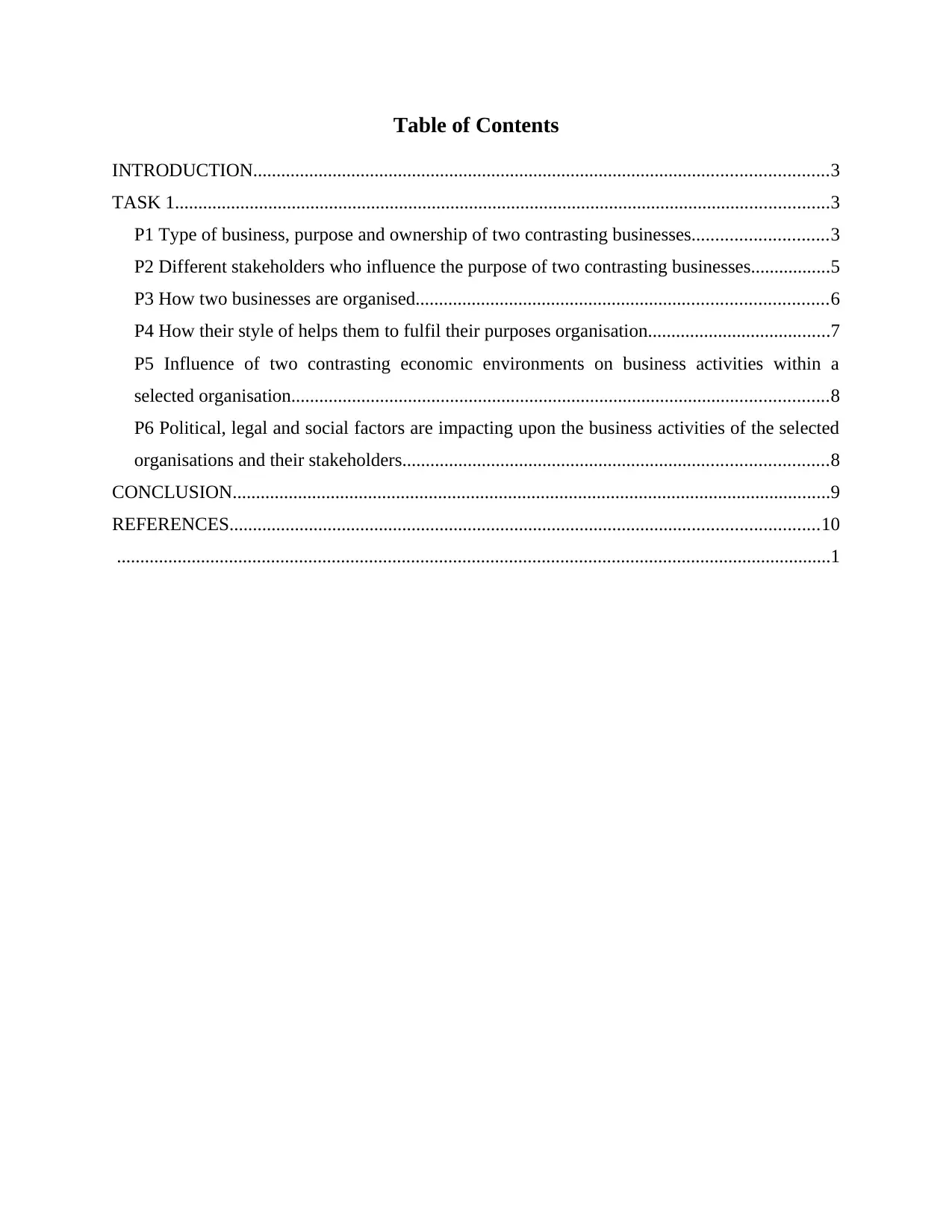
Table of Contents
INTRODUCTION...........................................................................................................................3
TASK 1............................................................................................................................................3
P1 Type of business, purpose and ownership of two contrasting businesses.............................3
P2 Different stakeholders who influence the purpose of two contrasting businesses.................5
P3 How two businesses are organised........................................................................................6
P4 How their style of helps them to fulfil their purposes organisation.......................................7
P5 Influence of two contrasting economic environments on business activities within a
selected organisation...................................................................................................................8
P6 Political, legal and social factors are impacting upon the business activities of the selected
organisations and their stakeholders...........................................................................................8
CONCLUSION................................................................................................................................9
REFERENCES..............................................................................................................................10
.........................................................................................................................................................1
INTRODUCTION...........................................................................................................................3
TASK 1............................................................................................................................................3
P1 Type of business, purpose and ownership of two contrasting businesses.............................3
P2 Different stakeholders who influence the purpose of two contrasting businesses.................5
P3 How two businesses are organised........................................................................................6
P4 How their style of helps them to fulfil their purposes organisation.......................................7
P5 Influence of two contrasting economic environments on business activities within a
selected organisation...................................................................................................................8
P6 Political, legal and social factors are impacting upon the business activities of the selected
organisations and their stakeholders...........................................................................................8
CONCLUSION................................................................................................................................9
REFERENCES..............................................................................................................................10
.........................................................................................................................................................1
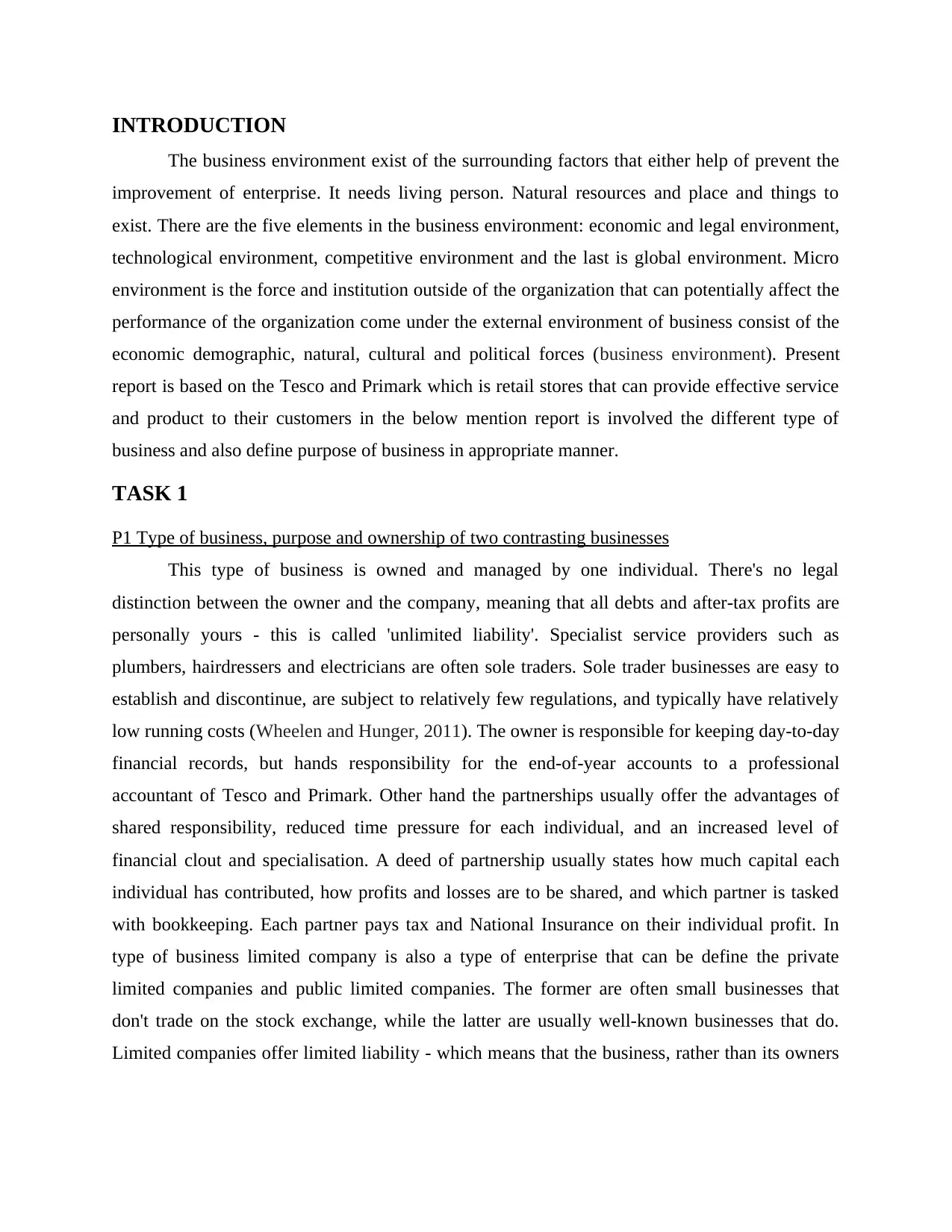
INTRODUCTION
The business environment exist of the surrounding factors that either help of prevent the
improvement of enterprise. It needs living person. Natural resources and place and things to
exist. There are the five elements in the business environment: economic and legal environment,
technological environment, competitive environment and the last is global environment. Micro
environment is the force and institution outside of the organization that can potentially affect the
performance of the organization come under the external environment of business consist of the
economic demographic, natural, cultural and political forces (business environment). Present
report is based on the Tesco and Primark which is retail stores that can provide effective service
and product to their customers in the below mention report is involved the different type of
business and also define purpose of business in appropriate manner.
TASK 1
P1 Type of business, purpose and ownership of two contrasting businesses
This type of business is owned and managed by one individual. There's no legal
distinction between the owner and the company, meaning that all debts and after-tax profits are
personally yours - this is called 'unlimited liability'. Specialist service providers such as
plumbers, hairdressers and electricians are often sole traders. Sole trader businesses are easy to
establish and discontinue, are subject to relatively few regulations, and typically have relatively
low running costs (Wheelen and Hunger, 2011). The owner is responsible for keeping day-to-day
financial records, but hands responsibility for the end-of-year accounts to a professional
accountant of Tesco and Primark. Other hand the partnerships usually offer the advantages of
shared responsibility, reduced time pressure for each individual, and an increased level of
financial clout and specialisation. A deed of partnership usually states how much capital each
individual has contributed, how profits and losses are to be shared, and which partner is tasked
with bookkeeping. Each partner pays tax and National Insurance on their individual profit. In
type of business limited company is also a type of enterprise that can be define the private
limited companies and public limited companies. The former are often small businesses that
don't trade on the stock exchange, while the latter are usually well-known businesses that do.
Limited companies offer limited liability - which means that the business, rather than its owners
The business environment exist of the surrounding factors that either help of prevent the
improvement of enterprise. It needs living person. Natural resources and place and things to
exist. There are the five elements in the business environment: economic and legal environment,
technological environment, competitive environment and the last is global environment. Micro
environment is the force and institution outside of the organization that can potentially affect the
performance of the organization come under the external environment of business consist of the
economic demographic, natural, cultural and political forces (business environment). Present
report is based on the Tesco and Primark which is retail stores that can provide effective service
and product to their customers in the below mention report is involved the different type of
business and also define purpose of business in appropriate manner.
TASK 1
P1 Type of business, purpose and ownership of two contrasting businesses
This type of business is owned and managed by one individual. There's no legal
distinction between the owner and the company, meaning that all debts and after-tax profits are
personally yours - this is called 'unlimited liability'. Specialist service providers such as
plumbers, hairdressers and electricians are often sole traders. Sole trader businesses are easy to
establish and discontinue, are subject to relatively few regulations, and typically have relatively
low running costs (Wheelen and Hunger, 2011). The owner is responsible for keeping day-to-day
financial records, but hands responsibility for the end-of-year accounts to a professional
accountant of Tesco and Primark. Other hand the partnerships usually offer the advantages of
shared responsibility, reduced time pressure for each individual, and an increased level of
financial clout and specialisation. A deed of partnership usually states how much capital each
individual has contributed, how profits and losses are to be shared, and which partner is tasked
with bookkeeping. Each partner pays tax and National Insurance on their individual profit. In
type of business limited company is also a type of enterprise that can be define the private
limited companies and public limited companies. The former are often small businesses that
don't trade on the stock exchange, while the latter are usually well-known businesses that do.
Limited companies offer limited liability - which means that the business, rather than its owners
⊘ This is a preview!⊘
Do you want full access?
Subscribe today to unlock all pages.

Trusted by 1+ million students worldwide
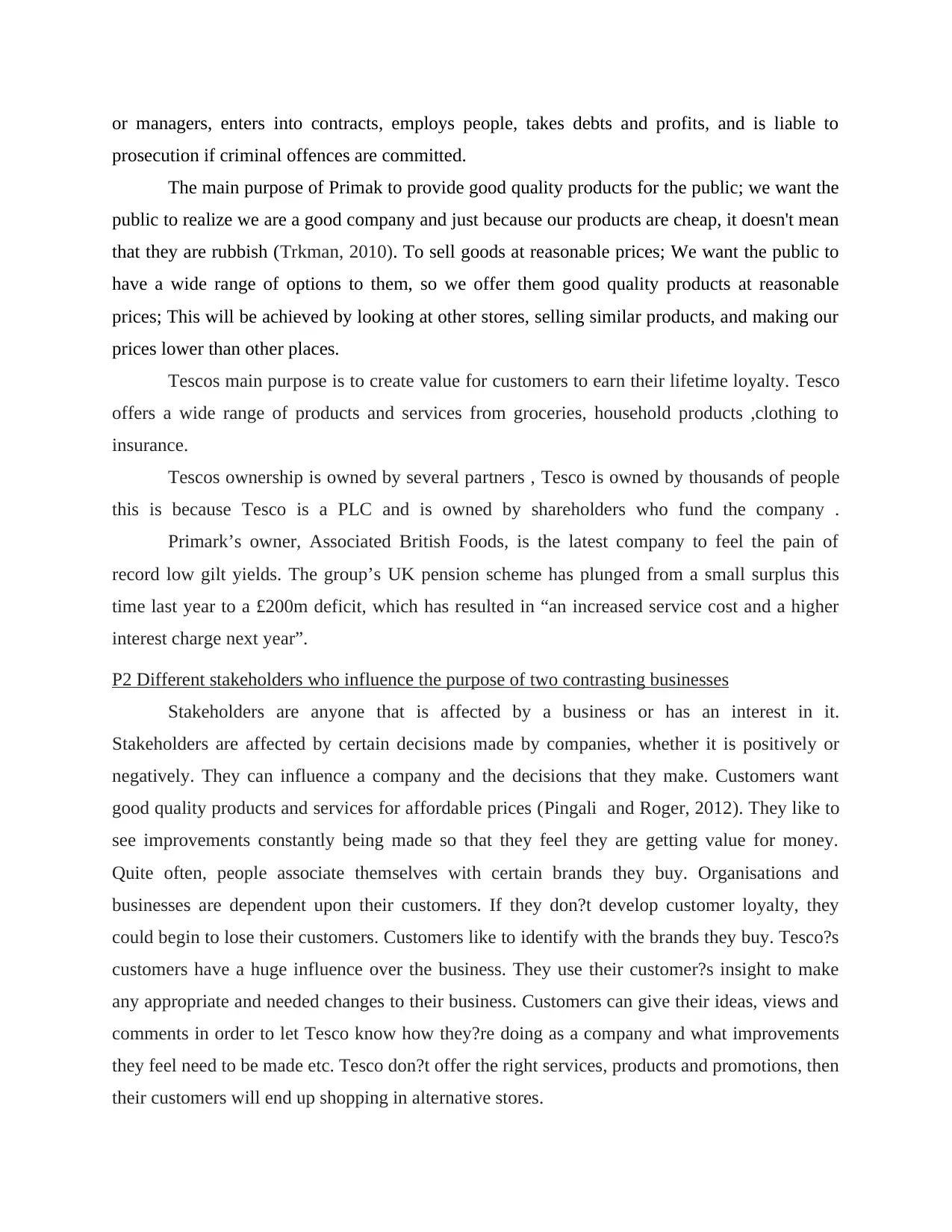
or managers, enters into contracts, employs people, takes debts and profits, and is liable to
prosecution if criminal offences are committed.
The main purpose of Primak to provide good quality products for the public; we want the
public to realize we are a good company and just because our products are cheap, it doesn't mean
that they are rubbish (Trkman, 2010). To sell goods at reasonable prices; We want the public to
have a wide range of options to them, so we offer them good quality products at reasonable
prices; This will be achieved by looking at other stores, selling similar products, and making our
prices lower than other places.
Tescos main purpose is to create value for customers to earn their lifetime loyalty. Tesco
offers a wide range of products and services from groceries, household products ,clothing to
insurance.
Tescos ownership is owned by several partners , Tesco is owned by thousands of people
this is because Tesco is a PLC and is owned by shareholders who fund the company .
Primark’s owner, Associated British Foods, is the latest company to feel the pain of
record low gilt yields. The group’s UK pension scheme has plunged from a small surplus this
time last year to a £200m deficit, which has resulted in “an increased service cost and a higher
interest charge next year”.
P2 Different stakeholders who influence the purpose of two contrasting businesses
Stakeholders are anyone that is affected by a business or has an interest in it.
Stakeholders are affected by certain decisions made by companies, whether it is positively or
negatively. They can influence a company and the decisions that they make. Customers want
good quality products and services for affordable prices (Pingali and Roger, 2012). They like to
see improvements constantly being made so that they feel they are getting value for money.
Quite often, people associate themselves with certain brands they buy. Organisations and
businesses are dependent upon their customers. If they don?t develop customer loyalty, they
could begin to lose their customers. Customers like to identify with the brands they buy. Tesco?s
customers have a huge influence over the business. They use their customer?s insight to make
any appropriate and needed changes to their business. Customers can give their ideas, views and
comments in order to let Tesco know how they?re doing as a company and what improvements
they feel need to be made etc. Tesco don?t offer the right services, products and promotions, then
their customers will end up shopping in alternative stores.
prosecution if criminal offences are committed.
The main purpose of Primak to provide good quality products for the public; we want the
public to realize we are a good company and just because our products are cheap, it doesn't mean
that they are rubbish (Trkman, 2010). To sell goods at reasonable prices; We want the public to
have a wide range of options to them, so we offer them good quality products at reasonable
prices; This will be achieved by looking at other stores, selling similar products, and making our
prices lower than other places.
Tescos main purpose is to create value for customers to earn their lifetime loyalty. Tesco
offers a wide range of products and services from groceries, household products ,clothing to
insurance.
Tescos ownership is owned by several partners , Tesco is owned by thousands of people
this is because Tesco is a PLC and is owned by shareholders who fund the company .
Primark’s owner, Associated British Foods, is the latest company to feel the pain of
record low gilt yields. The group’s UK pension scheme has plunged from a small surplus this
time last year to a £200m deficit, which has resulted in “an increased service cost and a higher
interest charge next year”.
P2 Different stakeholders who influence the purpose of two contrasting businesses
Stakeholders are anyone that is affected by a business or has an interest in it.
Stakeholders are affected by certain decisions made by companies, whether it is positively or
negatively. They can influence a company and the decisions that they make. Customers want
good quality products and services for affordable prices (Pingali and Roger, 2012). They like to
see improvements constantly being made so that they feel they are getting value for money.
Quite often, people associate themselves with certain brands they buy. Organisations and
businesses are dependent upon their customers. If they don?t develop customer loyalty, they
could begin to lose their customers. Customers like to identify with the brands they buy. Tesco?s
customers have a huge influence over the business. They use their customer?s insight to make
any appropriate and needed changes to their business. Customers can give their ideas, views and
comments in order to let Tesco know how they?re doing as a company and what improvements
they feel need to be made etc. Tesco don?t offer the right services, products and promotions, then
their customers will end up shopping in alternative stores.
Paraphrase This Document
Need a fresh take? Get an instant paraphrase of this document with our AI Paraphraser
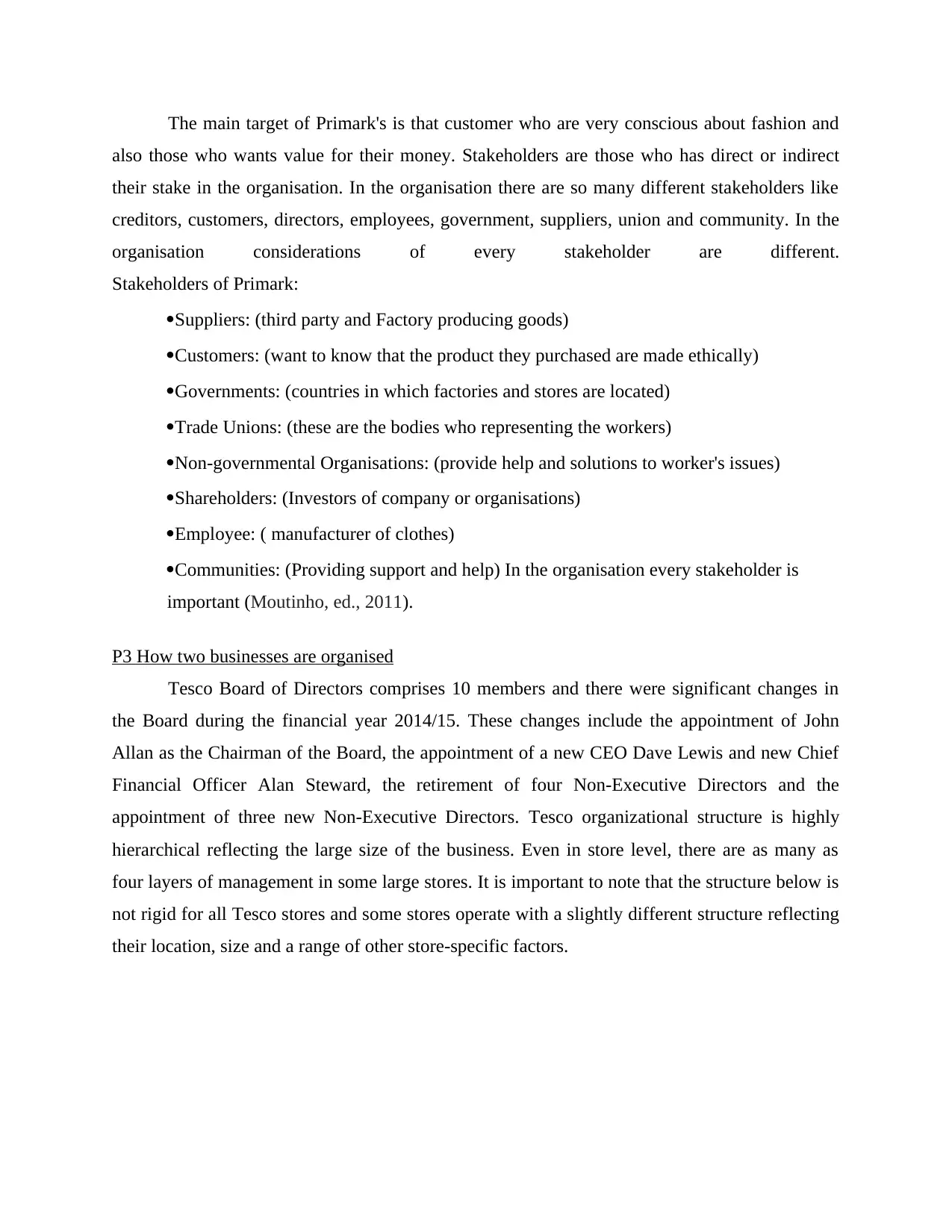
The main target of Primark's is that customer who are very conscious about fashion and
also those who wants value for their money. Stakeholders are those who has direct or indirect
their stake in the organisation. In the organisation there are so many different stakeholders like
creditors, customers, directors, employees, government, suppliers, union and community. In the
organisation considerations of every stakeholder are different.
Stakeholders of Primark:
Suppliers: (third party and Factory producing goods)
Customers: (want to know that the product they purchased are made ethically)
Governments: (countries in which factories and stores are located)
Trade Unions: (these are the bodies who representing the workers)
Non-governmental Organisations: (provide help and solutions to worker's issues)
Shareholders: (Investors of company or organisations)
Employee: ( manufacturer of clothes)
Communities: (Providing support and help) In the organisation every stakeholder is
important (Moutinho, ed., 2011).
P3 How two businesses are organised
Tesco Board of Directors comprises 10 members and there were significant changes in
the Board during the financial year 2014/15. These changes include the appointment of John
Allan as the Chairman of the Board, the appointment of a new CEO Dave Lewis and new Chief
Financial Officer Alan Steward, the retirement of four Non-Executive Directors and the
appointment of three new Non-Executive Directors. Tesco organizational structure is highly
hierarchical reflecting the large size of the business. Even in store level, there are as many as
four layers of management in some large stores. It is important to note that the structure below is
not rigid for all Tesco stores and some stores operate with a slightly different structure reflecting
their location, size and a range of other store-specific factors.
also those who wants value for their money. Stakeholders are those who has direct or indirect
their stake in the organisation. In the organisation there are so many different stakeholders like
creditors, customers, directors, employees, government, suppliers, union and community. In the
organisation considerations of every stakeholder are different.
Stakeholders of Primark:
Suppliers: (third party and Factory producing goods)
Customers: (want to know that the product they purchased are made ethically)
Governments: (countries in which factories and stores are located)
Trade Unions: (these are the bodies who representing the workers)
Non-governmental Organisations: (provide help and solutions to worker's issues)
Shareholders: (Investors of company or organisations)
Employee: ( manufacturer of clothes)
Communities: (Providing support and help) In the organisation every stakeholder is
important (Moutinho, ed., 2011).
P3 How two businesses are organised
Tesco Board of Directors comprises 10 members and there were significant changes in
the Board during the financial year 2014/15. These changes include the appointment of John
Allan as the Chairman of the Board, the appointment of a new CEO Dave Lewis and new Chief
Financial Officer Alan Steward, the retirement of four Non-Executive Directors and the
appointment of three new Non-Executive Directors. Tesco organizational structure is highly
hierarchical reflecting the large size of the business. Even in store level, there are as many as
four layers of management in some large stores. It is important to note that the structure below is
not rigid for all Tesco stores and some stores operate with a slightly different structure reflecting
their location, size and a range of other store-specific factors.
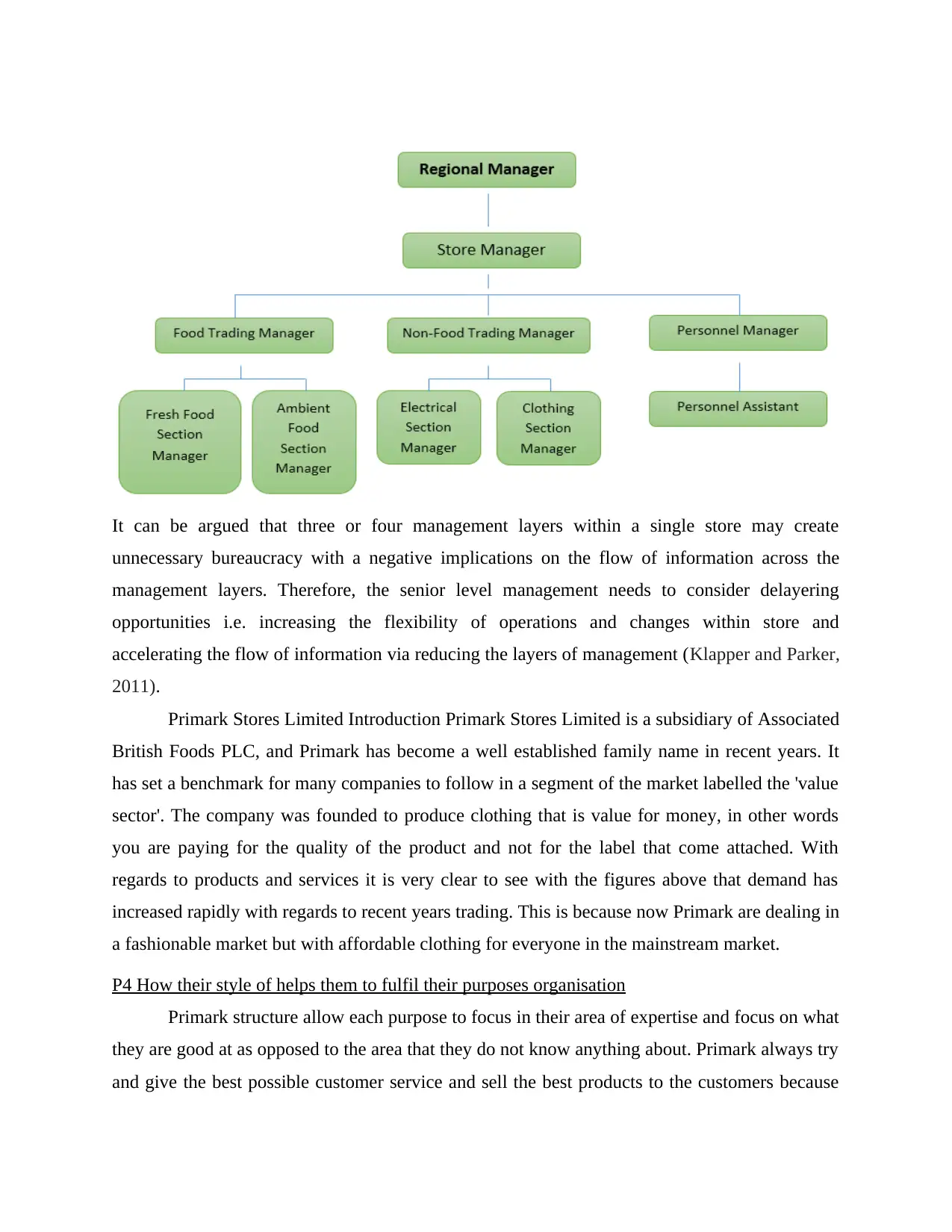
It can be argued that three or four management layers within a single store may create
unnecessary bureaucracy with a negative implications on the flow of information across the
management layers. Therefore, the senior level management needs to consider delayering
opportunities i.e. increasing the flexibility of operations and changes within store and
accelerating the flow of information via reducing the layers of management (Klapper and Parker,
2011).
Primark Stores Limited Introduction Primark Stores Limited is a subsidiary of Associated
British Foods PLC, and Primark has become a well established family name in recent years. It
has set a benchmark for many companies to follow in a segment of the market labelled the 'value
sector'. The company was founded to produce clothing that is value for money, in other words
you are paying for the quality of the product and not for the label that come attached. With
regards to products and services it is very clear to see with the figures above that demand has
increased rapidly with regards to recent years trading. This is because now Primark are dealing in
a fashionable market but with affordable clothing for everyone in the mainstream market.
P4 How their style of helps them to fulfil their purposes organisation
Primark structure allow each purpose to focus in their area of expertise and focus on what
they are good at as opposed to the area that they do not know anything about. Primark always try
and give the best possible customer service and sell the best products to the customers because
unnecessary bureaucracy with a negative implications on the flow of information across the
management layers. Therefore, the senior level management needs to consider delayering
opportunities i.e. increasing the flexibility of operations and changes within store and
accelerating the flow of information via reducing the layers of management (Klapper and Parker,
2011).
Primark Stores Limited Introduction Primark Stores Limited is a subsidiary of Associated
British Foods PLC, and Primark has become a well established family name in recent years. It
has set a benchmark for many companies to follow in a segment of the market labelled the 'value
sector'. The company was founded to produce clothing that is value for money, in other words
you are paying for the quality of the product and not for the label that come attached. With
regards to products and services it is very clear to see with the figures above that demand has
increased rapidly with regards to recent years trading. This is because now Primark are dealing in
a fashionable market but with affordable clothing for everyone in the mainstream market.
P4 How their style of helps them to fulfil their purposes organisation
Primark structure allow each purpose to focus in their area of expertise and focus on what
they are good at as opposed to the area that they do not know anything about. Primark always try
and give the best possible customer service and sell the best products to the customers because
⊘ This is a preview!⊘
Do you want full access?
Subscribe today to unlock all pages.

Trusted by 1+ million students worldwide
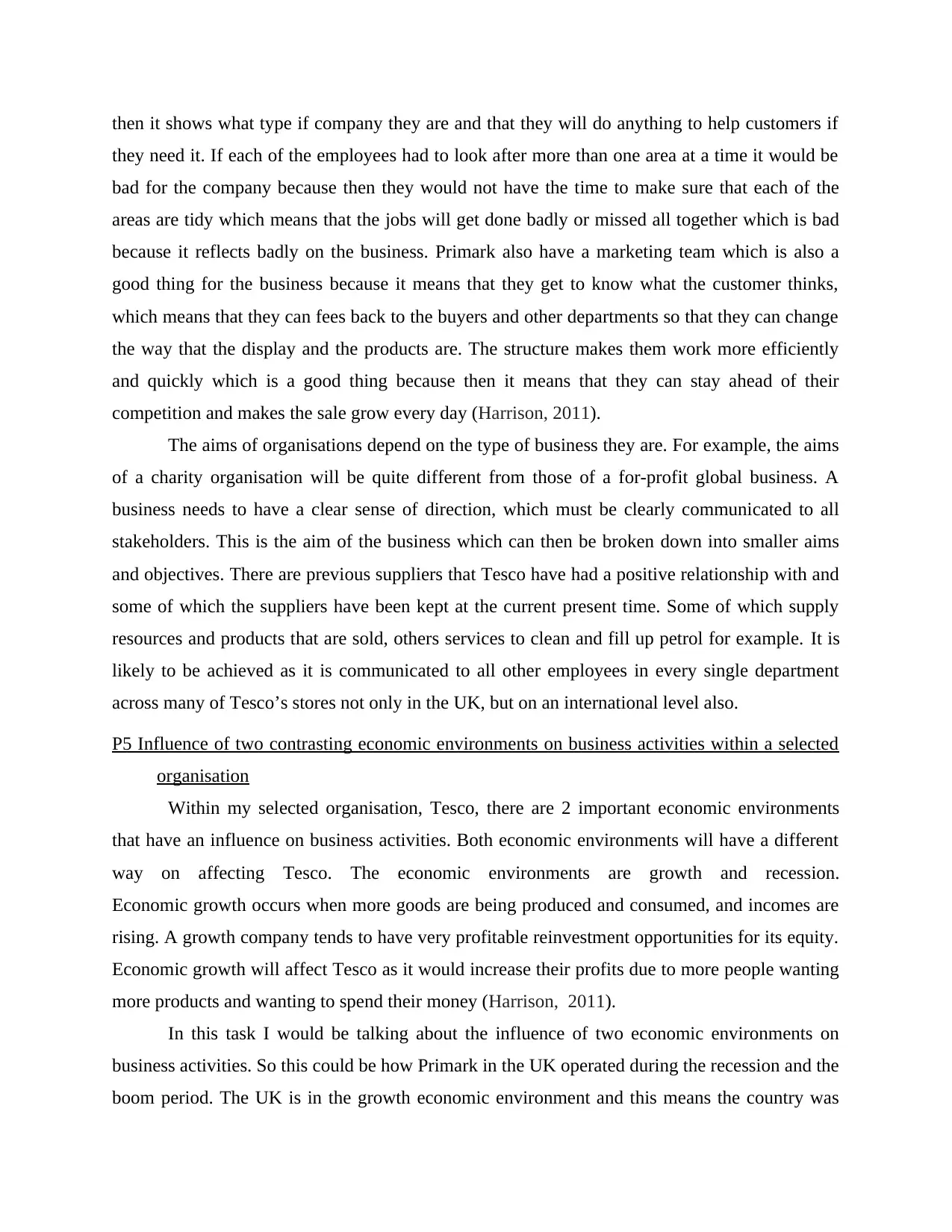
then it shows what type if company they are and that they will do anything to help customers if
they need it. If each of the employees had to look after more than one area at a time it would be
bad for the company because then they would not have the time to make sure that each of the
areas are tidy which means that the jobs will get done badly or missed all together which is bad
because it reflects badly on the business. Primark also have a marketing team which is also a
good thing for the business because it means that they get to know what the customer thinks,
which means that they can fees back to the buyers and other departments so that they can change
the way that the display and the products are. The structure makes them work more efficiently
and quickly which is a good thing because then it means that they can stay ahead of their
competition and makes the sale grow every day (Harrison, 2011).
The aims of organisations depend on the type of business they are. For example, the aims
of a charity organisation will be quite different from those of a for-profit global business. A
business needs to have a clear sense of direction, which must be clearly communicated to all
stakeholders. This is the aim of the business which can then be broken down into smaller aims
and objectives. There are previous suppliers that Tesco have had a positive relationship with and
some of which the suppliers have been kept at the current present time. Some of which supply
resources and products that are sold, others services to clean and fill up petrol for example. It is
likely to be achieved as it is communicated to all other employees in every single department
across many of Tesco’s stores not only in the UK, but on an international level also.
P5 Influence of two contrasting economic environments on business activities within a selected
organisation
Within my selected organisation, Tesco, there are 2 important economic environments
that have an influence on business activities. Both economic environments will have a different
way on affecting Tesco. The economic environments are growth and recession.
Economic growth occurs when more goods are being produced and consumed, and incomes are
rising. A growth company tends to have very profitable reinvestment opportunities for its equity.
Economic growth will affect Tesco as it would increase their profits due to more people wanting
more products and wanting to spend their money (Harrison, 2011).
In this task I would be talking about the influence of two economic environments on
business activities. So this could be how Primark in the UK operated during the recession and the
boom period. The UK is in the growth economic environment and this means the country was
they need it. If each of the employees had to look after more than one area at a time it would be
bad for the company because then they would not have the time to make sure that each of the
areas are tidy which means that the jobs will get done badly or missed all together which is bad
because it reflects badly on the business. Primark also have a marketing team which is also a
good thing for the business because it means that they get to know what the customer thinks,
which means that they can fees back to the buyers and other departments so that they can change
the way that the display and the products are. The structure makes them work more efficiently
and quickly which is a good thing because then it means that they can stay ahead of their
competition and makes the sale grow every day (Harrison, 2011).
The aims of organisations depend on the type of business they are. For example, the aims
of a charity organisation will be quite different from those of a for-profit global business. A
business needs to have a clear sense of direction, which must be clearly communicated to all
stakeholders. This is the aim of the business which can then be broken down into smaller aims
and objectives. There are previous suppliers that Tesco have had a positive relationship with and
some of which the suppliers have been kept at the current present time. Some of which supply
resources and products that are sold, others services to clean and fill up petrol for example. It is
likely to be achieved as it is communicated to all other employees in every single department
across many of Tesco’s stores not only in the UK, but on an international level also.
P5 Influence of two contrasting economic environments on business activities within a selected
organisation
Within my selected organisation, Tesco, there are 2 important economic environments
that have an influence on business activities. Both economic environments will have a different
way on affecting Tesco. The economic environments are growth and recession.
Economic growth occurs when more goods are being produced and consumed, and incomes are
rising. A growth company tends to have very profitable reinvestment opportunities for its equity.
Economic growth will affect Tesco as it would increase their profits due to more people wanting
more products and wanting to spend their money (Harrison, 2011).
In this task I would be talking about the influence of two economic environments on
business activities. So this could be how Primark in the UK operated during the recession and the
boom period. The UK is in the growth economic environment and this means the country was
Paraphrase This Document
Need a fresh take? Get an instant paraphrase of this document with our AI Paraphraser
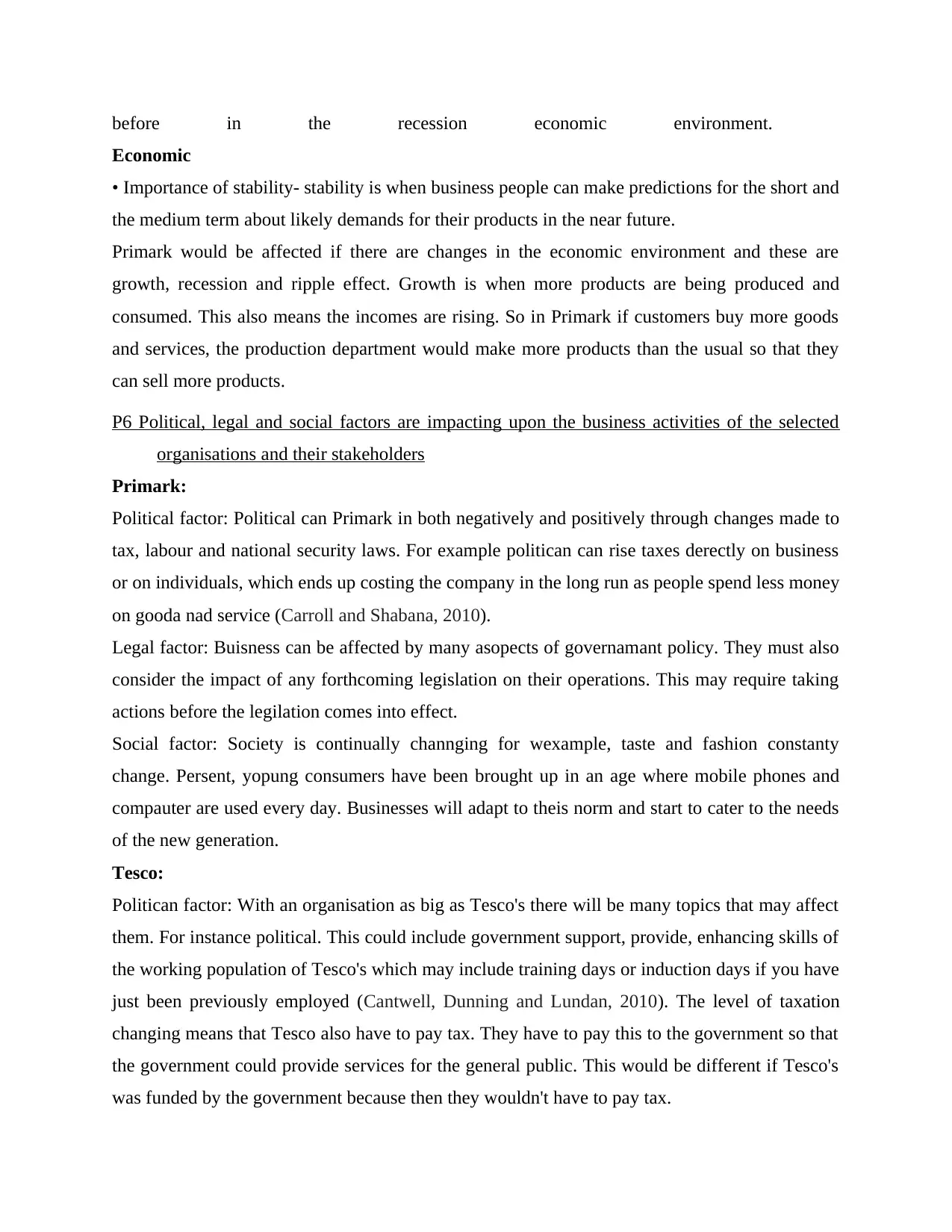
before in the recession economic environment.
Economic
• Importance of stability- stability is when business people can make predictions for the short and
the medium term about likely demands for their products in the near future.
Primark would be affected if there are changes in the economic environment and these are
growth, recession and ripple effect. Growth is when more products are being produced and
consumed. This also means the incomes are rising. So in Primark if customers buy more goods
and services, the production department would make more products than the usual so that they
can sell more products.
P6 Political, legal and social factors are impacting upon the business activities of the selected
organisations and their stakeholders
Primark:
Political factor: Political can Primark in both negatively and positively through changes made to
tax, labour and national security laws. For example politican can rise taxes derectly on business
or on individuals, which ends up costing the company in the long run as people spend less money
on gooda nad service (Carroll and Shabana, 2010).
Legal factor: Buisness can be affected by many asopects of governamant policy. They must also
consider the impact of any forthcoming legislation on their operations. This may require taking
actions before the legilation comes into effect.
Social factor: Society is continually channging for wexample, taste and fashion constanty
change. Persent, yopung consumers have been brought up in an age where mobile phones and
compauter are used every day. Businesses will adapt to theis norm and start to cater to the needs
of the new generation.
Tesco:
Politican factor: With an organisation as big as Tesco's there will be many topics that may affect
them. For instance political. This could include government support, provide, enhancing skills of
the working population of Tesco's which may include training days or induction days if you have
just been previously employed (Cantwell, Dunning and Lundan, 2010). The level of taxation
changing means that Tesco also have to pay tax. They have to pay this to the government so that
the government could provide services for the general public. This would be different if Tesco's
was funded by the government because then they wouldn't have to pay tax.
Economic
• Importance of stability- stability is when business people can make predictions for the short and
the medium term about likely demands for their products in the near future.
Primark would be affected if there are changes in the economic environment and these are
growth, recession and ripple effect. Growth is when more products are being produced and
consumed. This also means the incomes are rising. So in Primark if customers buy more goods
and services, the production department would make more products than the usual so that they
can sell more products.
P6 Political, legal and social factors are impacting upon the business activities of the selected
organisations and their stakeholders
Primark:
Political factor: Political can Primark in both negatively and positively through changes made to
tax, labour and national security laws. For example politican can rise taxes derectly on business
or on individuals, which ends up costing the company in the long run as people spend less money
on gooda nad service (Carroll and Shabana, 2010).
Legal factor: Buisness can be affected by many asopects of governamant policy. They must also
consider the impact of any forthcoming legislation on their operations. This may require taking
actions before the legilation comes into effect.
Social factor: Society is continually channging for wexample, taste and fashion constanty
change. Persent, yopung consumers have been brought up in an age where mobile phones and
compauter are used every day. Businesses will adapt to theis norm and start to cater to the needs
of the new generation.
Tesco:
Politican factor: With an organisation as big as Tesco's there will be many topics that may affect
them. For instance political. This could include government support, provide, enhancing skills of
the working population of Tesco's which may include training days or induction days if you have
just been previously employed (Cantwell, Dunning and Lundan, 2010). The level of taxation
changing means that Tesco also have to pay tax. They have to pay this to the government so that
the government could provide services for the general public. This would be different if Tesco's
was funded by the government because then they wouldn't have to pay tax.
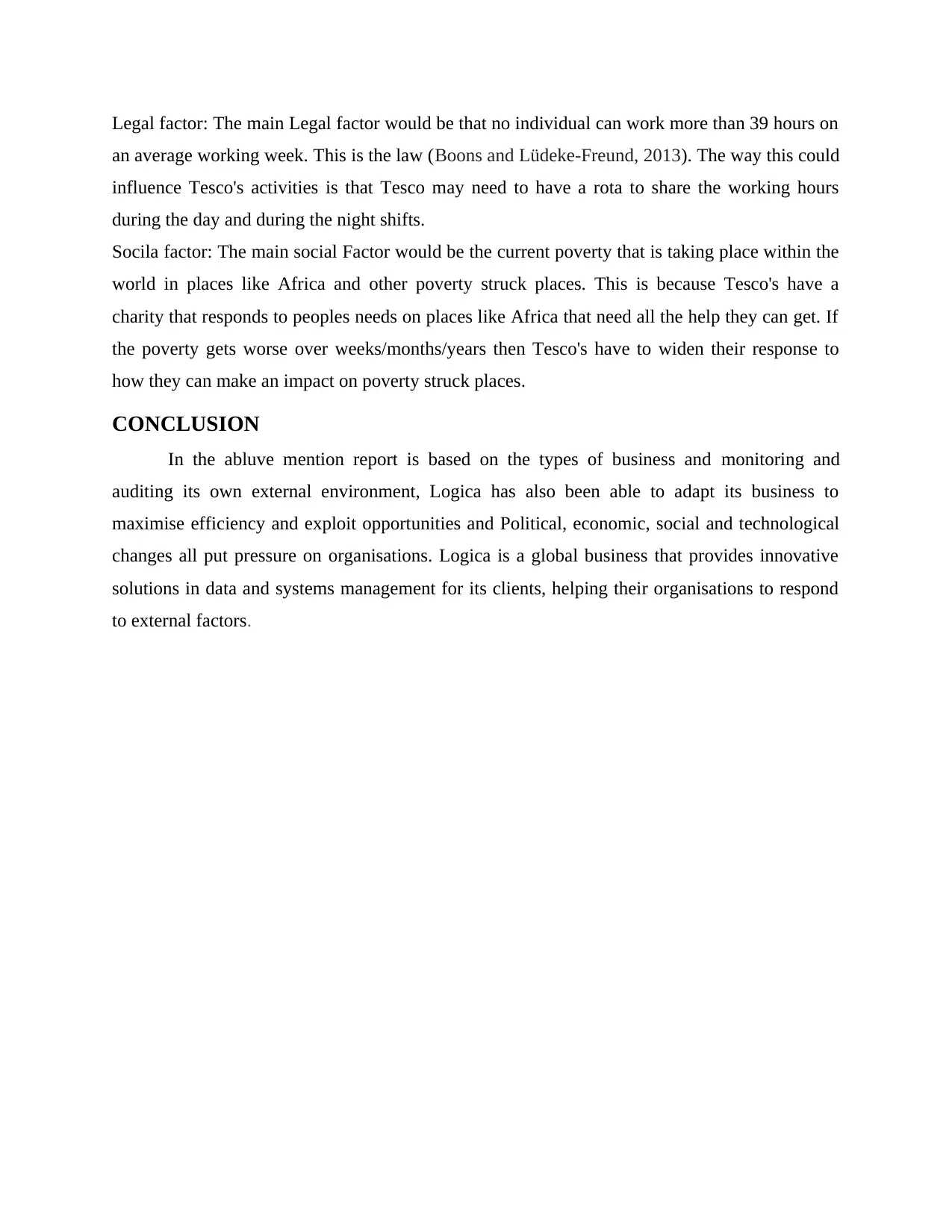
Legal factor: The main Legal factor would be that no individual can work more than 39 hours on
an average working week. This is the law (Boons and Lüdeke-Freund, 2013). The way this could
influence Tesco's activities is that Tesco may need to have a rota to share the working hours
during the day and during the night shifts.
Socila factor: The main social Factor would be the current poverty that is taking place within the
world in places like Africa and other poverty struck places. This is because Tesco's have a
charity that responds to peoples needs on places like Africa that need all the help they can get. If
the poverty gets worse over weeks/months/years then Tesco's have to widen their response to
how they can make an impact on poverty struck places.
CONCLUSION
In the abluve mention report is based on the types of business and monitoring and
auditing its own external environment, Logica has also been able to adapt its business to
maximise efficiency and exploit opportunities and Political, economic, social and technological
changes all put pressure on organisations. Logica is a global business that provides innovative
solutions in data and systems management for its clients, helping their organisations to respond
to external factors.
an average working week. This is the law (Boons and Lüdeke-Freund, 2013). The way this could
influence Tesco's activities is that Tesco may need to have a rota to share the working hours
during the day and during the night shifts.
Socila factor: The main social Factor would be the current poverty that is taking place within the
world in places like Africa and other poverty struck places. This is because Tesco's have a
charity that responds to peoples needs on places like Africa that need all the help they can get. If
the poverty gets worse over weeks/months/years then Tesco's have to widen their response to
how they can make an impact on poverty struck places.
CONCLUSION
In the abluve mention report is based on the types of business and monitoring and
auditing its own external environment, Logica has also been able to adapt its business to
maximise efficiency and exploit opportunities and Political, economic, social and technological
changes all put pressure on organisations. Logica is a global business that provides innovative
solutions in data and systems management for its clients, helping their organisations to respond
to external factors.
⊘ This is a preview!⊘
Do you want full access?
Subscribe today to unlock all pages.

Trusted by 1+ million students worldwide
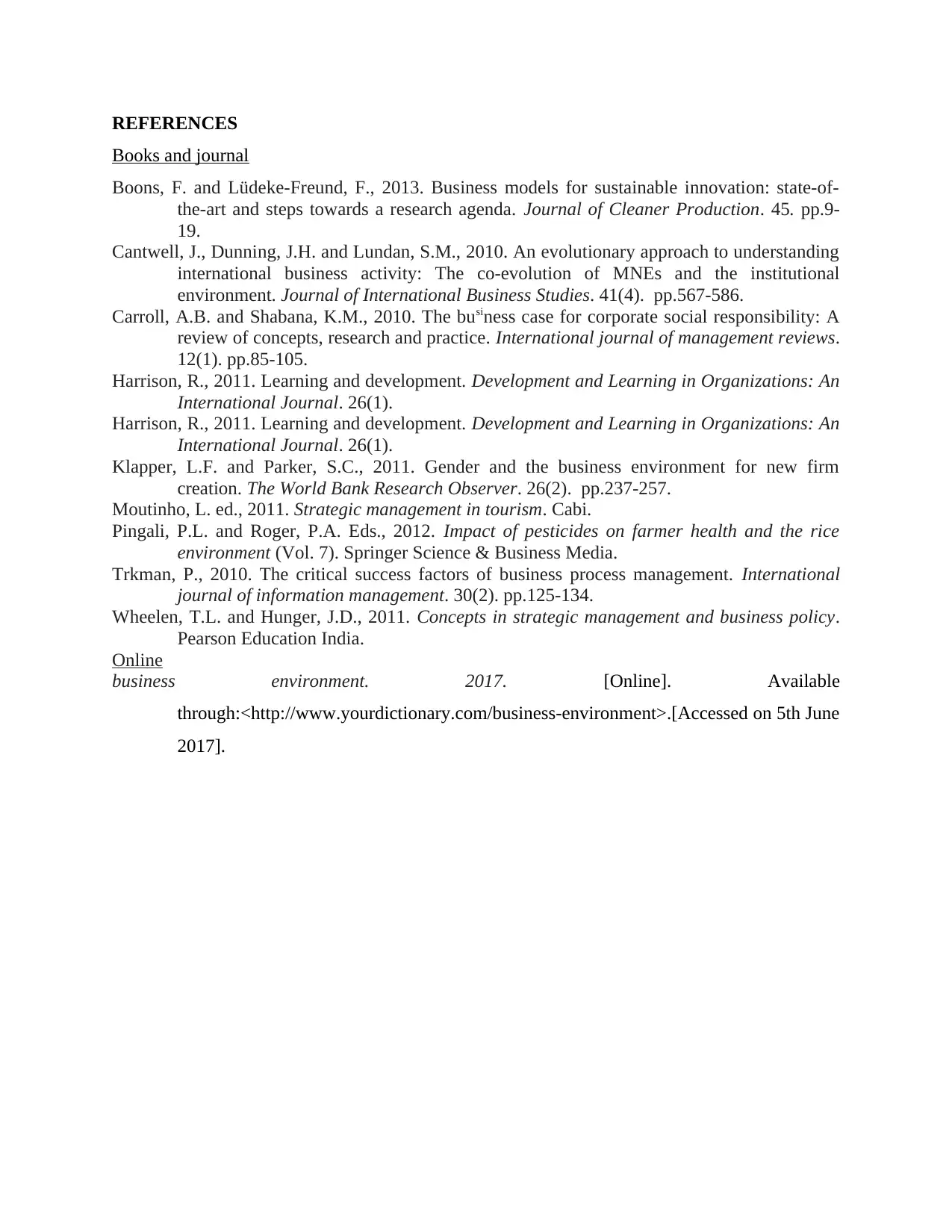
REFERENCES
Books and journal
Boons, F. and Lüdeke-Freund, F., 2013. Business models for sustainable innovation: state-of-
the-art and steps towards a research agenda. Journal of Cleaner Production. 45. pp.9-
19.
Cantwell, J., Dunning, J.H. and Lundan, S.M., 2010. An evolutionary approach to understanding
international business activity: The co-evolution of MNEs and the institutional
environment. Journal of International Business Studies. 41(4). pp.567-586.
Carroll, A.B. and Shabana, K.M., 2010. The business case for corporate social responsibility: A
review of concepts, research and practice. International journal of management reviews.
12(1). pp.85-105.
Harrison, R., 2011. Learning and development. Development and Learning in Organizations: An
International Journal. 26(1).
Harrison, R., 2011. Learning and development. Development and Learning in Organizations: An
International Journal. 26(1).
Klapper, L.F. and Parker, S.C., 2011. Gender and the business environment for new firm
creation. The World Bank Research Observer. 26(2). pp.237-257.
Moutinho, L. ed., 2011. Strategic management in tourism. Cabi.
Pingali, P.L. and Roger, P.A. Eds., 2012. Impact of pesticides on farmer health and the rice
environment (Vol. 7). Springer Science & Business Media.
Trkman, P., 2010. The critical success factors of business process management. International
journal of information management. 30(2). pp.125-134.
Wheelen, T.L. and Hunger, J.D., 2011. Concepts in strategic management and business policy.
Pearson Education India.
Online
business environment. 2017. [Online]. Available
through:<http://www.yourdictionary.com/business-environment>.[Accessed on 5th June
2017].
Books and journal
Boons, F. and Lüdeke-Freund, F., 2013. Business models for sustainable innovation: state-of-
the-art and steps towards a research agenda. Journal of Cleaner Production. 45. pp.9-
19.
Cantwell, J., Dunning, J.H. and Lundan, S.M., 2010. An evolutionary approach to understanding
international business activity: The co-evolution of MNEs and the institutional
environment. Journal of International Business Studies. 41(4). pp.567-586.
Carroll, A.B. and Shabana, K.M., 2010. The business case for corporate social responsibility: A
review of concepts, research and practice. International journal of management reviews.
12(1). pp.85-105.
Harrison, R., 2011. Learning and development. Development and Learning in Organizations: An
International Journal. 26(1).
Harrison, R., 2011. Learning and development. Development and Learning in Organizations: An
International Journal. 26(1).
Klapper, L.F. and Parker, S.C., 2011. Gender and the business environment for new firm
creation. The World Bank Research Observer. 26(2). pp.237-257.
Moutinho, L. ed., 2011. Strategic management in tourism. Cabi.
Pingali, P.L. and Roger, P.A. Eds., 2012. Impact of pesticides on farmer health and the rice
environment (Vol. 7). Springer Science & Business Media.
Trkman, P., 2010. The critical success factors of business process management. International
journal of information management. 30(2). pp.125-134.
Wheelen, T.L. and Hunger, J.D., 2011. Concepts in strategic management and business policy.
Pearson Education India.
Online
business environment. 2017. [Online]. Available
through:<http://www.yourdictionary.com/business-environment>.[Accessed on 5th June
2017].
Paraphrase This Document
Need a fresh take? Get an instant paraphrase of this document with our AI Paraphraser

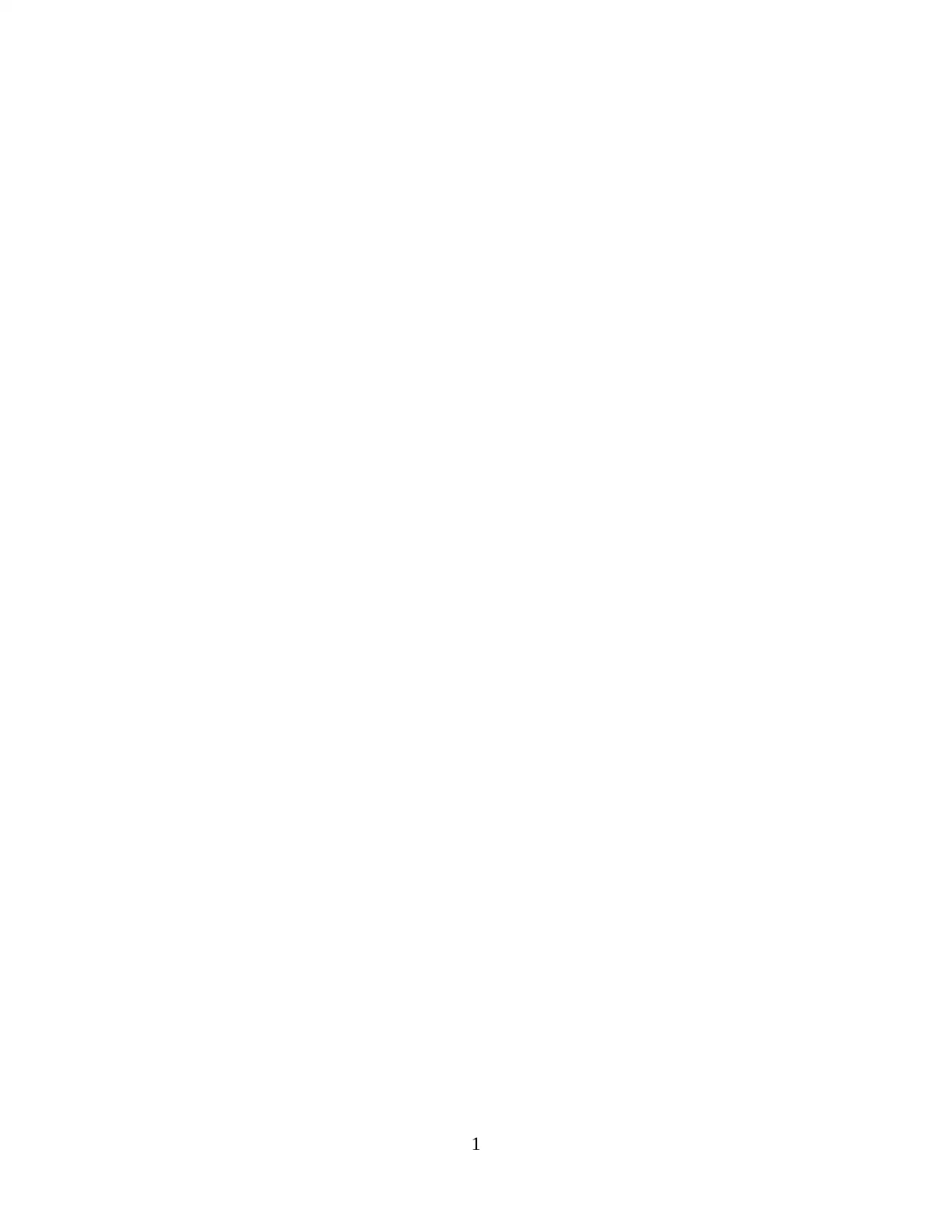
1
⊘ This is a preview!⊘
Do you want full access?
Subscribe today to unlock all pages.

Trusted by 1+ million students worldwide
1 out of 12
Related Documents
Your All-in-One AI-Powered Toolkit for Academic Success.
+13062052269
info@desklib.com
Available 24*7 on WhatsApp / Email
![[object Object]](/_next/static/media/star-bottom.7253800d.svg)
Unlock your academic potential
Copyright © 2020–2025 A2Z Services. All Rights Reserved. Developed and managed by ZUCOL.





